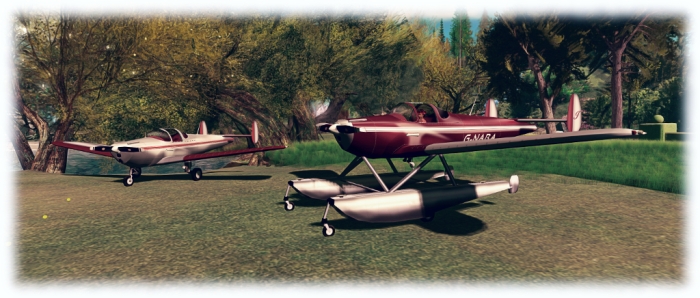
I think I’ve established the fact I quite like flying in Second Life, and I particularly enjoy DSA aircraft as they are fun to fly, look good, are nicely customisable, paint-wise,, and many have both wheel and float options – the latter being essential when living on an island. It’s been a while since I’ve actually purchased anything in the aeroplane line; truth be told, I hadn’t intended to get anything beyond what is already sitting in my inventory.
Then I saw the DSA had released the Aerohawk, and for the last week it has been nagging at me, finally reaching a point where I had to just give in and buy it. As it is not (at the time of writing, at least) available on the Marketplace, so in-world store visit is required to see it.
Like most of my aircraft choices, I was drawn to the Aerohawk purely on its looks – in this case, stylishly retro. It was only after talking to my friend Jodi, that I discovered it is modelled after the ERCO Ercoupe, which first flew in 1940 and was designed to be the safest fixed-wing aircraft that aerospace engineering could provide at the time. It is still popular today, and during its time was licensed to manufacturers the world over.

The DSA aircraft faithfully reproduces the look of the original, and is supplied in a silver metal finish with red trim by default. As is the case with all DSA aircraft, the texture files can be downloaded from the DSA website, allowing owners and third parties to produce custom / alternative paint schemes. In terms of land impact, the aircraft hits 53 LI, which is “heavier” than my DSA G58 Baron (46 LI), but is just over half the Baron’s rendering weight, being something of a simpler design.
I’m not the world’s greatest when it comes to graphics, but in lieu of VetronUK having an Aerohawk kit at present, I took to GIMP and imported the PSD files to produce an initial personalised paint scheme I’m reasonably happy with in about 15-20 minutes. I still need to add materials to give it a decent finish, but it’s enough to keep me happy. Manual application of colour schemes follows the usual route for DSA ‘planes: edit the aircraft, select the face, apply the texture file; repeat as the faces require.

Handling-wise, the Aerohawk comes with the usual DSA HUD, but it is a little more hands-on (when compared to the likes of Baron and King Air, at least), requiring manual toggling of lights. The engine sound is nicely “veteran”. In the air, I found it to be nicely responsive and – while it may simply have been a placebo effect or down to conditions being a little different – I encountered no significant issues region crossing issues when only a few days ago, I was finding myself climbing out of Blake Sea and digging my Baron out of Lost and Found sufficiently often enough to have me packing up and going home.
Interior-wise, the Aerohawk is in keeping with its looks: it’s all vinyl and cloth. The instrument panel as reasonably well detailed; DSA aircraft can sometimes suffer from blurred textures of the instruments, but there is little of that here. On the ground and in flight, it handles pretty much like any other DSA ‘plane, making it an ideal easy flier for those who simply want to get out and in the air without getting overly close to trying to fly like “the real thing”.

A very minor niggle with the plane is the sliding cockpit doors can be a tad tricky: click on one and the other can sometimes go down when “opening” them; I now click the white bar marking their edges rather than clicking from the side to avoid this (not that you need to have them open to get into the ‘plane, of course, hence this being a minor niggle).
If I’m totally honest, I’m hoping that VetronUK (if she is still active in SL) will bring out support kits – painting, float rocking and enhanced lighting. In part because my graphics skills do sucketh the proverbial lemon, but mostly because her kits really bring aircraft in SL to life. Until then, however, I’ll make do with my own painting efforts, and at least the Aerohawk looks at home alongside Caitlyn’s Baron 🙂 .

